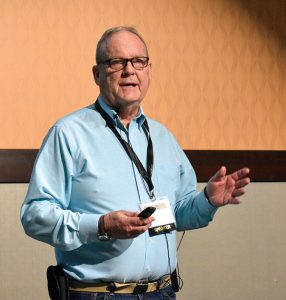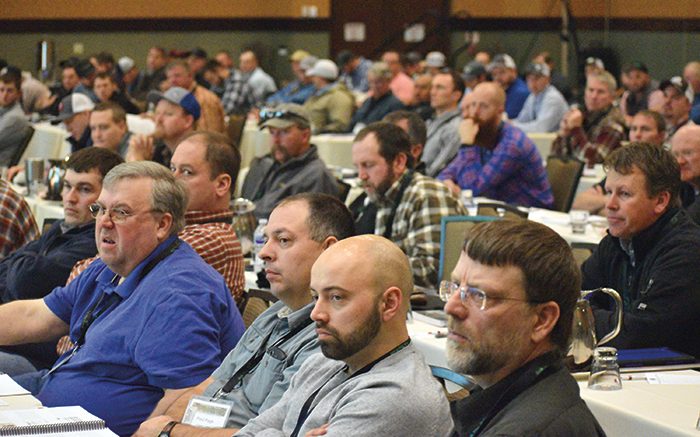Story and photos by Allen Thayer

Larry Zibilske, vice-president of research at TPS Lab, talks about soil biology’s effects on plants and nutrients, using organic matter to enhance crop nutrition, water use efficiency and managing poor-quality irrigation water.
Nearly 150 people attended the sold-out Spud School 2018, a two-day workshop for growers, field consultants and fertilizer suppliers, held Jan. 15-16 in Fort Hall, Idaho. TPS Lab offered the event to share new approaches to season-long proactive crop fertilization management for better yields and quality at lower cost.
“You name it, we grow it,” said Noel Garcia, a certified crop advisor who joined TPS Lab in 1991 and now serves as vice president of operations and technical director. TPS Lab is located in Edinburg, Texas.
With participants from every corner of the U.S. and Canada filling the room for the class, which preceded the Idaho Potato Conference in Pocatello, Garcia kicked off the event with a workshop on soil testing.
“The overall idea is to spoon-feed the plant,” Garcia said. “There is no guarantee nutrients will get into the plant.”
Garcia illustrated how leaf and petiole (sap) testing, in conjunction with soil fertility testing, enables growers to manage crop nutrition needs to a high level and to rapidly respond to changing growing conditions and stressors before they affect production. He drew from real-life examples of slow wet springs and lingering drought to show growers how they can correct for erratic weather using testing and foliar sprays.
While soil tests are essential to getting a crop started, many things can influence how much and what of the recommended fertilizer put down actually gets into the plant.
“At the end of the day, all you really want to know is how much of what you need to put down to get your next crop off to a good start,” Garcia said.
Garcia said one way growers can correct nutritional problems before they see them is with TPS Lab’s Ask the Plant. This is the lab’s signature suite of petiole (sap) and leaf tests with proprietary nutritional interpretations and recommendations that are continuously updated for latest varieties and hybrids. The plant analysis identifies nutritional problems and increases yields, quality and profits by allowing correction of nutritional deficiencies in the plant at critical stages of growth seven to 21 days before it shows visible signs of stress, according to the company.
The goal of Ask the Plant is to make dramatically superior crops – even under adverse growing conditions. The program includes soil, plant and irrigation water testing.
Other subjects presented at Spud School included crop nutrition, potato nutritional requirements and foliar nutrition on potato plants.
“The key is balanced nutrition throughout the growing season,” Garcia said. “Now we can properly balance nutrients.”
He told growers that very few fertility studies and on-farm trials are being done and urged attendees to change that.
“The more information you get from crop advisors, the better off you are.”
He said continued improvement in cropping system management and use of site-specific precision ag technologies, such as drones, have led to better nitrogen fertilizer efficiency.
“Too many farmers put too much nitrogen on too early,” Garcia said.
Additionally, Garcia said growers need to view potassium and phosphorus efficiency as different from nitrogen efficiency. The difference method (RE) is appropriate for nitrogen, but is less useful for phosphorus and potassium where plant available reserves of these nutrients can accumulate in the soil from past applications of fertilizer.
“It’s critical to properly define efficiency for the nutrient in question,” Garcia said. “Yields will likely continue to increase faster than nitrogen use.”
“Sustainable efficiency will translate into increased phosphorus and potassium demand in some major production regions. The pressure to improve nitrogen efficiency should result in increased support for balanced nutrition with phosphorus and potassium.”
Garcia emphasized the importance of making nutrients available when crops need them.
“If you’re applying at the wrong time, it’s not being utilized.”
Videos of the workshop will be available at www.tpslab.com.


